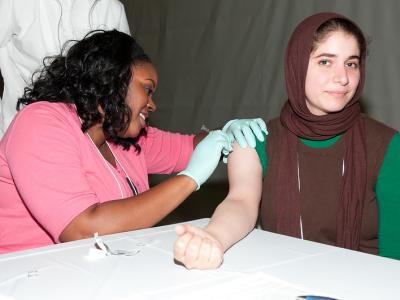Feb 7, 2008 (CIDRAP News) – European health officials today reported signs of an increasing rate of resistance to oseltamivir (Tamiflu) in Europe's predominant subtype of influenza virus, but they cautioned that the rate seen in isolates tested so far may not reflect the real situation.
The European Centre for Disease Prevention and Control (ECDC) reported that 20% (151 of 755) of influenza A/H1N1 isolates tested so far had a mutation linked with resistance. That compares with 14% (59 of 437 isolates) reported a week ago.
"However, these changes probably mostly reflect vigorous testing" by national influenza centers, the United Kingdom Health Protection Agency, and a World Health Organization (WHO) collaborating center in London, the ECDC stated in Eurosurveillance Weekly. "Hence, week-on-week changes need to be interpreted cautiously, as they are more a reflection of having more testing than any changes in the underlying epidemiology."
Norway still has the highest rate of resistance at 63% (42 of 66 isolates), but this is down from about 72% reported a week ago. Meanwhile, the rate doubled in France, to 39% (81 of 208 isolates). Germany had a rate of 8.5% (7 of 82 isolates) and the United Kingdom had 6.6% (12 of 181). Most other European countries reported few or no resistant isolates.
In a separate online statement today, the ECDC said, "From the limited data, the proportion of influenza viruses exhibiting resistance to oseltamivir must be significant, but probably not as high as in Norway."
In the United States, 8.4% (15 of 179) of the H1N1 viruses tested so far had the resistance mutation, according to a WHO table that was updated today. The table shows a 6.3% (8 of 128) resistance rate for Canadian isolates.
Oseltamivir resistance has also been reported in 5.6% (2 of 36) H1N1 isolates in Australia and in 7.5% (5 of 67) in Hong Kong, the WHO table shows. In Japan, where the antiviral is used much more than in most other countries, no resistant viruses have been reported.
The WHO table shows resistance has been found in a total of 14 countries, 10 of them in Europe. The overall resistance rate is about 6%, or 89 of 1,396 isolates. No resistance has been found in the few African and Latin American countries where testing has been done, according to the WHO.
While H1N1 is the predominant flu strain in Europe this winter, about a third of specimens tested are influenza B, the Eurosurveillance report said.
European officials repeated previous statements that this year's flu vaccine is expected to be as effective against the resistant viruses as against susceptible ones. They also said the experience in Norway suggests that people infected with the resistant variant do not seem to get sicker than those infected with susceptible strains.
See also:
Feb 7 Eurosurveillance update
http://www.eurosurveillance.org/ViewArticle.aspx?ArticleId=8032
Feb 1 CIDRAP News story "Europe says Tamiflu-resistant virus seen in 9 countries"





















